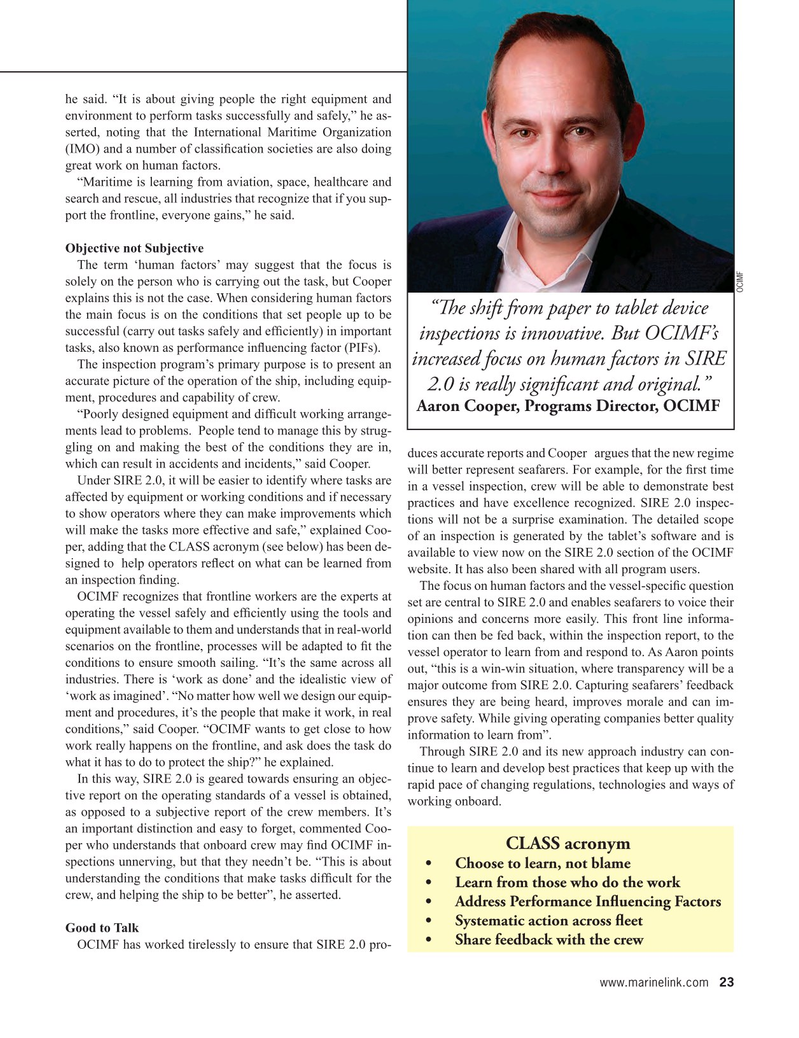
Page 23: of Maritime Reporter Magazine (June 2023)
The Digital Ship
Read this page in Pdf, Flash or Html5 edition of June 2023 Maritime Reporter Magazine
he said. “It is about giving people the right equipment and environment to perform tasks successfully and safely,” he as- serted, noting that the International Maritime Organization (IMO) and a number of classi? cation societies are also doing great work on human factors.
“Maritime is learning from aviation, space, healthcare and search and rescue, all industries that recognize that if you sup- port the frontline, everyone gains,” he said.
Objective not Subjective
The term ‘human factors’ may suggest that the focus is solely on the person who is carrying out the task, but Cooper
OCIMF explains this is not the case. When considering human factors “T e shift from paper to tablet device the main focus is on the conditions that set people up to be successful (carry out tasks safely and ef? ciently) in important inspections is innovative. But OCIMF’s tasks, also known as performance in? uencing factor (PIFs). increased focus on human factors in SIRE
The inspection program’s primary purpose is to present an accurate picture of the operation of the ship, including equip- 2.0 is really signif cant and original.” ment, procedures and capability of crew.
Aaron Cooper, Programs Director, OCIMF “Poorly designed equipment and dif? cult working arrange- ments lead to problems. People tend to manage this by strug- gling on and making the best of the conditions they are in, duces accurate reports and Cooper argues that the new regime which can result in accidents and incidents,” said Cooper.
will better represent seafarers. For example, for the ? rst time
Under SIRE 2.0, it will be easier to identify where tasks are in a vessel inspection, crew will be able to demonstrate best affected by equipment or working conditions and if necessary practices and have excellence recognized. SIRE 2.0 inspec- to show operators where they can make improvements which tions will not be a surprise examination. The detailed scope will make the tasks more effective and safe,” explained Coo- of an inspection is generated by the tablet’s software and is per, adding that the CLASS acronym (see below) has been de- available to view now on the SIRE 2.0 section of the OCIMF signed to help operators re? ect on what can be learned from website. It has also been shared with all program users.
an inspection ? nding.
The focus on human factors and the vessel-speci? c question
OCIMF recognizes that frontline workers are the experts at set are central to SIRE 2.0 and enables seafarers to voice their operating the vessel safely and ef? ciently using the tools and opinions and concerns more easily. This front line informa- equipment available to them and understands that in real-world tion can then be fed back, within the inspection report, to the scenarios on the frontline, processes will be adapted to ? t the vessel operator to learn from and respond to. As Aaron points conditions to ensure smooth sailing. “It’s the same across all out, “this is a win-win situation, where transparency will be a industries. There is ‘work as done’ and the idealistic view of major outcome from SIRE 2.0. Capturing seafarers’ feedback ‘work as imagined’. “No matter how well we design our equip- ensures they are being heard, improves morale and can im- ment and procedures, it’s the people that make it work, in real prove safety. While giving operating companies better quality conditions,” said Cooper. “OCIMF wants to get close to how information to learn from”.
work really happens on the frontline, and ask does the task do
Through SIRE 2.0 and its new approach industry can con- what it has to do to protect the ship?” he explained.
tinue to learn and develop best practices that keep up with the
In this way, SIRE 2.0 is geared towards ensuring an objec- rapid pace of changing regulations, technologies and ways of tive report on the operating standards of a vessel is obtained, working onboard. as opposed to a subjective report of the crew members. It’s an important distinction and easy to forget, commented Coo-
CLASS acronym per who understands that onboard crew may ? nd OCIMF in- spections unnerving, but that they needn’t be. “This is about • Choose to learn, not blame understanding the conditions that make tasks dif? cult for the • Learn from those who do the work crew, and helping the ship to be better”, he asserted.
• Address Performance Inf uencing Factors • Systematic action across f eet
Good to Talk • Share feedback with the crew
OCIMF has worked tirelessly to ensure that SIRE 2.0 pro- www.marinelink.com 23
MR #6 (18-33).indd 23 6/5/2023 9:06:57 AM

 22
22

 24
24
